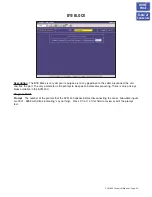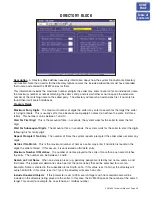
Examples:
●
3??? – Match any four-digit number beginning with “3”.
●
411 – Match “411” only.
●
???5000 – Match any seven-digit number ending in “5000”.
●
??? – Match any three-digit number.
Prefix
The Dial Prefix instructs SVM 400 what DTMF to dial, if any, prior to the actual number. Prefix examples
include a tie line or trunk access code. One example is shown in the Off-Premise Station Block: ‘9,’ tells SVM
400 to dial “9” and then pause before dialing the actual telephone number.
See the instructions for entering
specific characters at the end of this section.
Suffix
Enter any DTMF that must be dialed after the actual number. This will usually be left blank but may
include an account code or PBX feature code. Beepers usually require some form of DTMF entry after the tele-
phone number.
See the instructions for entering specific characters at the end of this section.
Transfer Controls
Simultaneous Xfers - Y/N. Set this parameter to ‘Y’ to allow more than one port to transfer
to the same station simultaneously. This applies to blind transfer conditions only.
Conference Calls - Y/N
Allows SVM 400 to place a conference call to the station controlled by the Station
Block.
Message Waiting Indicator Controls
Dial To Set MWI On
Enter the string needed to turn message waiting indicators on. Since the SVM 400 knows
how to do this internally, you would only use these to set MSG light on remote systems.
Dial To Set MWI Off
Enter the string needed to turn message waiting indicators off. Since the SVM 400 knows
how to do this internally, you would only use these to set MSG lights on remote systems.
Call Progress Training
The station block can be used to train the SVM 400 to recognize different call progress tones (ring back and
busy) for the particular station block. However, this is normally not necessary as default values for North
America are already programmed in.
Ringing Number
Enter any string returned by the phone system to indicate ring. The second field indicates
how many times the train routine is to be run using the number entered in the first field.
Busy Number
Enter any string returned by the phone system to indicate busy. The second field indicates
how many times the train routine is to be run using the number entered in the first field.
Retrain - Y/N
Set to ‘Y’ to preserve the original values. Set to ‘N’ to clear.
Retrain – Train
To run the Call Progress Train routine, enter a telephone number in either the ringing number
field, the busy number field, or both fields. Specify the number of times SVM 400 is to try the number to gather
data. Press ENTER to start Call Progress Training. Four conditions apply to the train routine:
●
If only the Ringing Number value is filled in, only those values which pertain to a ring signal will be modi-
fied by running the Call Progress Train routine.
●
If only the Busy Number value is filled in, only those values which pertain to a busy signal will be modified
by running the Call Progress Train routine.
●
If no numbers are provided for Ringing or Busy, and Retrain is set to ‘N’, the factory default settings are
automatically filled in by SVM 400.
●
If no numbers are provided for Ringing or Busy, and Retrain is set to ‘Y’, SVM 400 will give an error warn-
ing.
There are five types of Station Blocks preset on SVM 400: Template, Beeper, Long Distance, Off-Premise, and
On-Premise.
Each of these station block types comes with factory preset settings which should not be changed. If you want
to change any of these parameter settings, press ‘Ctrl + A’ to bring up the Copy Block dialog. Enter a new
name for the block and press ENTER. You now have a new Station Block. Make the necessary parameter set-
ting changes to the new block and assign it as necessary. Save the original five station blocks with their factory
default settings for future reference and use.
SVM 400 Technical Manual Page 49
HOME
PAGE
Table of
Contents
















































